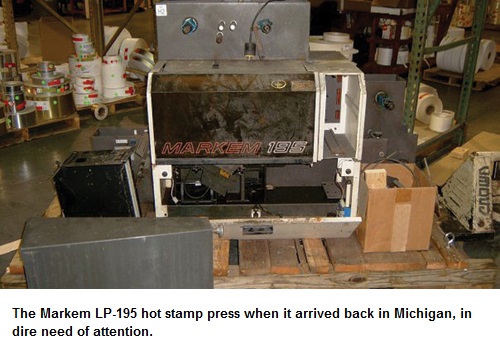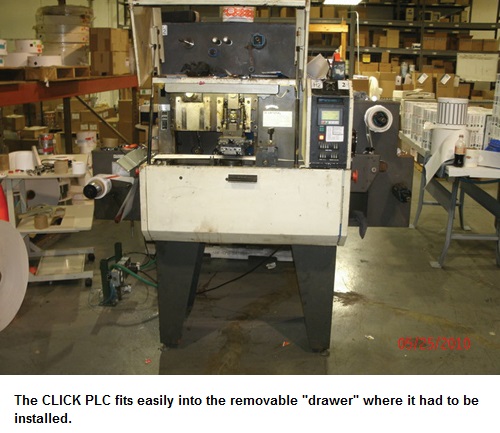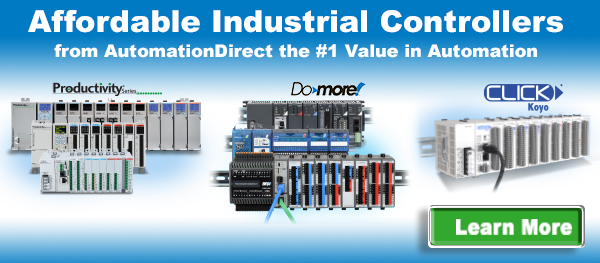An innovative employee at American Label & Tag was an automation neophyte, but AutomationDirect’s customer support showed him the way.
American Label & Tag was incorporated in 1988 and is based in Canton, Michigan. The company’s original mission was to produce high quality pressure sensitive labels. After expanding into the tag market in 1997, the company moved into its current custom-built facility in Canton, Mich.
Today, American Label & Tag services the digital print-on-demand market, using its capabilities to produce all required artwork, graphics, design and plate making. In addition, the company is a national distributor of printers, software, bar coding systems and accessories. The company sells labels and tags nationally and internationally.
American Label & Tag prides itself on having team members who are problem solvers, not just order takers. The company is a great representation of American manufacturing, and its maintenance supervisor Bill Dobiesz is an equally great example of American ingenuity.
When Dobiesz started working at the company’s Canton plant in October 2003, there were four Markem LP-195 hot stamp presses at the facility, but only one was operational. The machines were no longer being supported by the manufacturer, so over the years three of the machines had been cannibalized for parts.
Many readers will recognize aspects of Dobiesz’ personality in themselves; he was the kid who would take apart the vacuum cleaner and the telephone to figure out how they worked. His mechanical inclination led him to the career he has today, in which his spirit of learning how things work has made him a valuable asset to the company.
Not content to see the machines sitting idle, Dobiesz devoted extensive time and effort, including making some parts on his own, to get two of the forgotten machines operational. It was a project he did largely on his own time and with his own money, as he couldn’t resist the challenge. During the project, he got to know the machines pretty well from the inside out. He knew they were high quality hot stamp presses, and he was determined that the problem of unavailable replacement parts wouldn’t stop him.
Taking on New Challenges
The economic downturn in 2008 affected many companies, and American Label & Tag was no exception. Fortunately, American Label & Tag has a very hands-on owner who is involved in the business at every level. He knew he had many good employees who would be willing to learn other job duties to help the company through the recession. Dobiesz thought that he could get the hot stamp presses running again, so he volunteered to work on them.
 At one point he told Tim Gleason, president of American Label & Tag, he wished he hadn’t taken the other Markem LP-195 machine to Florida because he thought he could get it running. Gleason had faith in him, because one phone call and two days later, the machine arrived back in Michigan. But, Dobiesz thought he might have made a big mistake when he saw the state of the machine.
At one point he told Tim Gleason, president of American Label & Tag, he wished he hadn’t taken the other Markem LP-195 machine to Florida because he thought he could get it running. Gleason had faith in him, because one phone call and two days later, the machine arrived back in Michigan. But, Dobiesz thought he might have made a big mistake when he saw the state of the machine.
Dobiesz had to learn how the machine worked on his own because the operational sister machine was at the company’s other plant in Daytona Beach, Fla. Moreover, two of the items that had been stripped for use in the other machine were the control switchboard and the electromechanical counter, basically the machine’s entire automation system. The electromechanical counter was still available, but it was expensive and limited in functionality.
Searching for a better solution, Dobiesz saw a magazine ad for the CLICK PLC from AutomationDirect. Confident in his abilities, he used his own money to buy the PLC and a power supply. He was able to do this because the CLICK PLC was very economically priced, and because the downloadable programming software was free.
Small Size, Big Performance
In addition to its low price and long list of capabilities, the CLICK PLC was very small. Unlike any of other printing machines at the company, this one had all the controls in a removable drawer. Installing the new PLC anywhere but in this drawer would have presented problems, and the CLICK PLC’s small size made this option a reality.
After purchasing the CLICK PLC, Dobiesz realized he’d also need to provide an operator interface for the machine, so he naturally turned to AutomationDirect and bought a C-more Micro-Graphic touch panel with a three-inch display. Using the PLC and the touchscreen, he found he could now exceed the original capabilities of the machine for less money than it would cost to restore the original functionality.

The original mechanical predetermining counter had a maximum count of 99,999. It would count every stroke and would stop at the preset, which had to be a value less than or equal to 99,999. This reduced the efficiency of operation, as it’s not unusual to have jobs of 120,000 to 300,000 copies. With the CLICK PLC and the touchscreen, the machine is now capable of counting to 9,999,999.
Dobiesz also added a counter stop switch that enables the machine to operate without advancing the count, as well as a counter bypass switch that enables the machine to continue to operate in excess of its predetermined count.
New Functionality Added with Ease
Thanks to the large amount of program memory space in both in the PLC and the touchscreen, Dobiesz was able to add needed functionality via screens, counters, timers and more—all at no additional hardware or software cost.
“As long as I have inputs and outputs for connections, my imagination is the only limit to what I can do. If adding additional software-programmable switches, time delays or control relays add needed functionality—I just update the program, load it and I’m running,” says Dobiesz.
He has set up the ability to change the screen color when the predetermined count is reached, when any of the bypass functions are enabled, or if guards are opened. In addition, the touchscreen beeps if a guard is opened, an emergency stop is pushed, or if the preset is reached.
By operating the other machines, Dobiesz learned the best way to reset the counter was by having it appear on another screen. Using this method, the counter is easy to reset, but requires a deliberate action to avoid mistakenly resetting it in the middle of a job.He was also able to use the touchscreen to add a shift counter that an operator can reset to show how many jobs have been done in a shift, a week, a month, or any other time period. In addition, Dobiesz also created a single cycle function, similar to jog, that allows the machine to execute one cycle, then stop, which is used to save materials during setup.
 One feature of which he is particularly proud is the “mini batch” counter. An operator can set this counter so that the machine executes a certain number of cycles, then stops. This gives the operator time to clear the machine and stack parts before pressing the start button for the next mini batch. The mini-batch counter functions within the main counter, so the machine is still keeping track of the total batch count.
One feature of which he is particularly proud is the “mini batch” counter. An operator can set this counter so that the machine executes a certain number of cycles, then stops. This gives the operator time to clear the machine and stack parts before pressing the start button for the next mini batch. The mini-batch counter functions within the main counter, so the machine is still keeping track of the total batch count.
Using Dobiesz’ solution, it’s possible to retrofit the entire automation system of any existing Markem LP-195 or LP-385 machine with a low cost, high performing and reliable AutomationDirect control system consisting of a CLICK PLC and a C-more Micro-Graphic touch panel.
Great Help from Real Users
As the CLICK PLC and the C-more touchscreen were new to Dobiesz, he needed assistance with many tasks, from basic installation practices to programming. He found AutomationDirect’s Customer Forum (https://forum.automationdirect.com) to be a great help, as he could discuss his situation with other users who would walk him through solutions in real-time online.
“The AutomationDirect Customer Forum is one of the biggest and best user groups in the automation world,” says Dobiesz. “There were helpful replies from the AutomationDirect tech people, to be sure—but the ground zero, hold-my-hand-and-walk-me-through-it advice I needed was from other forum members. I’m happy to share my information with others, I’m known as DetroitSound. Maybe I can help someone who is struggling as I was, so that they too can get the personal triumph of solving a problem of their own,” offers Dobiesz.
As Dobiesz was now familiar with the CLICK PLC and C-more touchscreen, he decided to use these components on weekend project, namely an older washing machine in his house that was no longer running. The electronic timer failed, and the parts were no longer available. Dobiesz was able to use the programming experience he gained from the hot stamp printing machines to fix his own washing machine, and it ran several more years until it developed mechanical issues.
Dobiesz reprogrammed the C-more touchscreen he had bought for the washing machine, and he now uses it as a detachable testing device for his other projects at the plant. He says that he’s been able to successfully complete many projects because of the economical prices AutomationDirect offers, and because of the Customer Forum where he knows he can always quickly get any assistance he needs.
By Christine Lesher
To read more articles similar to this, click here.
Disclaimer: AutomationDirect does not guarantee the products described in this article are suitable for your particular application, nor do we assume any responsibility for your product/system design, installation, or operation.
Originally Posted: Dec. 12, 2012


